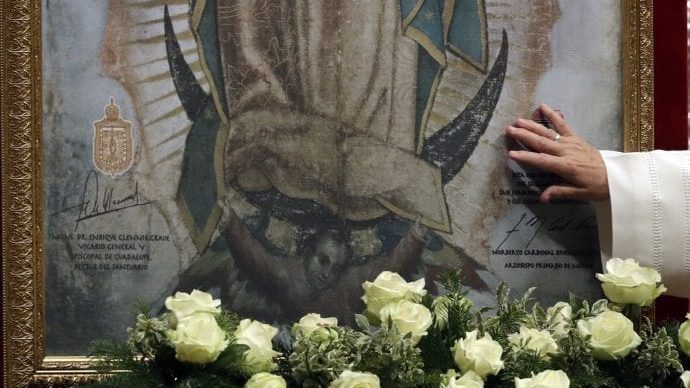With much of Latin America in the throes of months of social and political unrest, the continent’s bishops have turned to the “Empress of the Americas” to lend a hand in the effort for peace.
The Episcopal Conferences of Latin America and the Caribbean (CELAM) have launched a continent-wide day of prayer for peace on Dec. 12, the feast day of Our Lady of Guadalupe, Latin America’s most famous Marian apparition.
With conflicts raging in Bolivia, Colombia, Chile, Ecuador, Haiti, Nicaragua and Venezuela, CELAM says the move is a bid to end the violence by entrusting “the pains and joys” of Latin Americans to Mary, one of whose many titles is “Queen of Peace.”
“The objective is to unite ourselves in prayer with a common intention for all countries on the continent: obtaining peace,” they said, urging parishes, movements, bishops’ conferences and families to pray the rosary, attend Mass or the Liturgy of the Word, and to dedicate a special time during the day to pray for peace on the continent, recommending St. Francis of Assisi’s “Make Me an Instrument of Your Peace” prayer.
The bishops also urged those who participate to snap a picture or take a video of what they do and post it to social media with the hashtag “#AmericaLatinaRezaPorLaPaz”.
In the pope’s native Argentina, bishops have urged Catholics to pray the Prayer of St. Francis, while other countries have organized their own national days of prayer, such as Colombia, which 2-6 p.m. local time on Dec. 12 is organizing an afternoon of prayer, singing and reflection culminating with Mass at the headquarters of the bishops’ conference in Bogota.
Launched with the hashtag “#OremosPorColombia”, the event, according to the bishops, is intended “to strengthen in the Colombian people the need and the importance of the value of constant prayer to God in the building of peace and justice in our country, so that prayer illuminates the national reality we are living.”
During the celebrations, a special prayer will be recited to Our Lady of Guadalupe as part of CELAM’s continental prayer campaign.
Tradition holds that Mary appeared to an Indian man named Juan Diego on Dec. 9, 1521, while he was walking on Tepeyac Hill, a major Aztec landmark. The woman spoke to Juan Diego in his native language and wore the dress of an Aztec princess.
Local accounts say that she asked Juan Diego to tell the bishop about her, and when he did, the bishop asked for a sign to prove that the apparition was real. When Juan Diego told Mary about the bishop’s request, she reportedly told him to come back to the same spot the next day, where he would find flowers, despite the winter weather.
Juan Diego missed the appointment due to caring for his sick uncle, however, after seeing Mary again while passing Tepeyac two days later, she assured him everything would be fine and told him to do as she had said.
The next day he did as she asked and found roses in full bloom. He collected them in his tilma, a traditional cloth garment at the time, and carried them to the bishops’ residence. When he arrived, he opened his tilma and as the roses fell, an image appeared on his garment that has come to be known as the “Guadalupana.” The image, which has survived some 500 years, is considered a scientific anomaly.
The name “Guadalupe” comes from the indigenous word Coatlaxoepuh, meaning “the one who defeated the serpent,” as the image on the garment portrays.
A famous song bearing the “Guadalupana” title is still sung in churches and households throughout Latin America on Our Lady of Guadalupe’s feast.
The image, packed full of local symbolism, has been credited with leading to millions of conversions to the Catholic faith in less than seven years.
In 1737, Our Lady of Guadalupe was declared patroness of Mexico. In 1910, she was declared Patroness and Empress of the Americas, and some years later, she was even declared Patroness of the Philippines - which had long been a part of the Spanish Empire - which is why the basilica in Mexico City displays the 24 flags from every American country, and the flag of the Philippines.
The Guadalupe shrine is one of the most visited Marian destinations in the world, with some five million pilgrims coming annually for the Dec. 12 feast during a high-traffic year.
Pope Francis visited the shrine in 2016. In his homily during the visit, he said that with Mary’s apparition to Juan Diego, “God roused the hope of the little ones, of the suffering, of those displaced or rejected, of all who feel they have no worthy place in these lands.”
“God came close and still comes close to the suffering but resilient hearts of so many mothers, fathers, grandparents who have seen their children leaving, becoming lost or even being taken by criminals,” he said, adding, “Just as she made herself present to little Juan, so, too, she continues to reveal herself to all of us, especially to those who feel, like him, ‘worthless.’”
As he does each year, Francis will celebrate Mass in St. Peter’s Basilica to mark the feast of Our Lady of Guadalupe, and it’s likely that the plight of Latin America’s conflicted countries will be on his mind.
In their announcement for the day of prayer, CELAM urged each country throughout Latin America to share images and videos of where they are and how they are marking the day, noting that Guadalupe’s message is one for the “harmony for all peoples in one civilization of love and surrender to God.”
“In the Guadalupe event, Mary makes perfect the inculturation of the Gospel, she is our model of a disciple and missionary to whom we entrust the destiny of our peoples.”

